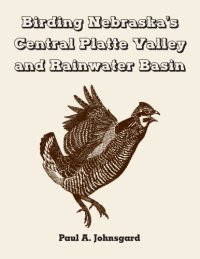
Ebook: Birding Nebraska’s Central Platte Valley and Rainwater Basin
Author: Paul A. Johnsgard
- Genre: Biology // Zoology
- Tags: ornithology migration Platte River Grand Island cranes ducks geese sandpipers waterfowl
- Year: 2015
- Publisher: Zea Books
- City: Lincoln, Nebraska
- Language: English
- pdf
Central Nebraska's Platte River and Rainwater Basin are primary stops in the migration patterns of numerous North American waterfowl, including sandhill and whooping cranes, sandpipers, geese, ducks, gulls, and shorebirds of many types. Upland species also abound there as well. The region's most eminent ornithologist provides birding and travel information for casual tourists and hard-core enthusiasts: locations, seasons, events, routes, accommodations, contacts, etc. A complete species list is also included. This birders' guide is as essential as your boots and binoculars.
The central Platte River Valley region, as defined by Brown & Johnsgard (2012) and adopted here, encompasses 12 south-central Nebraska counties and 9,745 square miles, from the western edge of Lincoln County to the eastern edge of Merrick County. The associated counties include Adams, Buffalo, Clay, Dawson, Frontier, Gosper, Hall, Hamilton, Kearney, Lincoln, Merrick and Phelps counties This region overlaps substantially with the Rainwater Basin in Adams, Clay, Gosper, Hall, Kearney, and Hamilton counties. The Rainwater Basin extends over some 4,400 square miles in area, from Gosper County east and north to Fillmore, York and Polk counties, and southeast to include northern parts of Franklin, Nuckolls, and Thayer counties (Map. I).
The central Platte Valley provides some of the best spring birding opportunities in all of North America; for most of March about seven million waterfowl and about half a million sandhill cranes pour into the region, remaining until late March in the case of the waterfowl and about the second week of April in the case of the sandhill cranes. As the last sandhill cranes are leaving, Whooping cranes begin to arrive, as do the earlier shorebirds, continuing the amazing spring spectacle until about the middle of May.
'The Rainwater Basin is just as attractive as the Platte Valley during early spring, when snow meltwaters accumulate in the clay-rich lowlands and an estimated 7-9 million ducks and 2-3 million geese pass through. These flocks include up to 80 percent of the mid-continental greater white-fronted goose population, 50 percent of the mid-continental mallard population, and 30 percent of the entire continent's northern pintail population. Increasing numbers of snow geese also use the region each spring, the numbers often exceeding two million birds.
The central Platte River Valley region, as defined by Brown & Johnsgard (2012) and adopted here, encompasses 12 south-central Nebraska counties and 9,745 square miles, from the western edge of Lincoln County to the eastern edge of Merrick County. The associated counties include Adams, Buffalo, Clay, Dawson, Frontier, Gosper, Hall, Hamilton, Kearney, Lincoln, Merrick and Phelps counties This region overlaps substantially with the Rainwater Basin in Adams, Clay, Gosper, Hall, Kearney, and Hamilton counties. The Rainwater Basin extends over some 4,400 square miles in area, from Gosper County east and north to Fillmore, York and Polk counties, and southeast to include northern parts of Franklin, Nuckolls, and Thayer counties (Map. I).
The central Platte Valley provides some of the best spring birding opportunities in all of North America; for most of March about seven million waterfowl and about half a million sandhill cranes pour into the region, remaining until late March in the case of the waterfowl and about the second week of April in the case of the sandhill cranes. As the last sandhill cranes are leaving, Whooping cranes begin to arrive, as do the earlier shorebirds, continuing the amazing spring spectacle until about the middle of May.
'The Rainwater Basin is just as attractive as the Platte Valley during early spring, when snow meltwaters accumulate in the clay-rich lowlands and an estimated 7-9 million ducks and 2-3 million geese pass through. These flocks include up to 80 percent of the mid-continental greater white-fronted goose population, 50 percent of the mid-continental mallard population, and 30 percent of the entire continent's northern pintail population. Increasing numbers of snow geese also use the region each spring, the numbers often exceeding two million birds.
Download the book Birding Nebraska’s Central Platte Valley and Rainwater Basin for free or read online
Continue reading on any device:

Last viewed books
Related books
{related-news}
Comments (0)